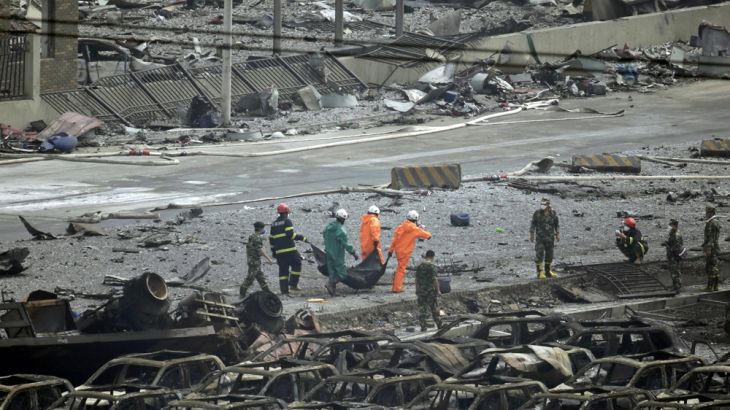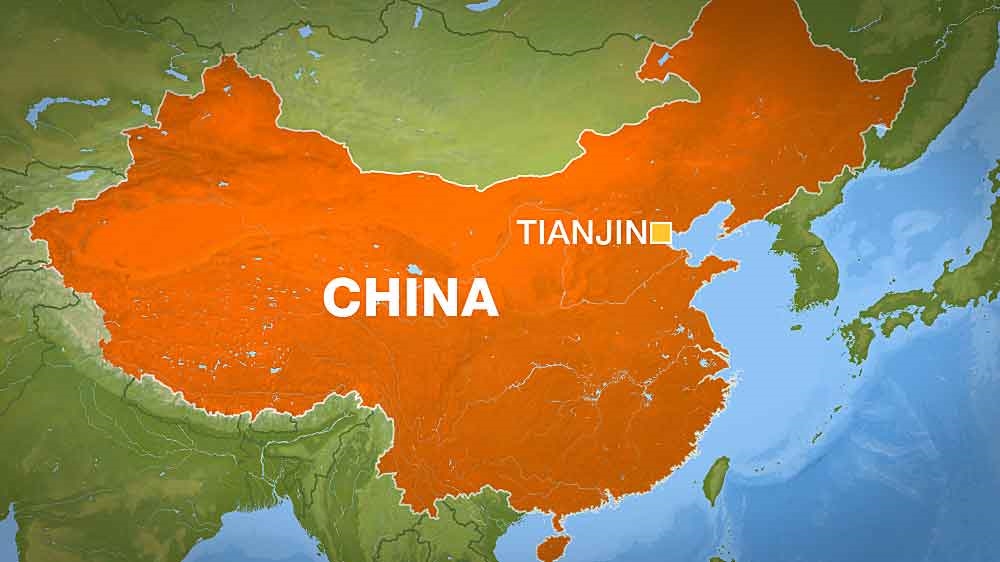China sends chemical experts to Tianjin blast site
Military begins work on the ground in northern port city where two explosions have left at least 55 dead.

China has sent chemical experts into Tianjin to test for toxic gases after a series of deadly explosions.
The team of nuclear and chemical experts is on the ground on Friday in the northern port city of Tianjin, the scene of two massive explosions that have left at least 55 people dead.
Keep reading
list of 4 itemsAre seed-sowing drones the answer to global deforestation?
Rainfall set to help crews battling wildfire near Canada’s Fort McMurray
The Alabama town living and dying in the shadow of chemical plants
Meanwhile, locals have expressed fears for their safety after reports there could be hundreds of tonnes of dangerous chemicals at the site.
Al Jazeera’s Adrian Brown, reporting from Tianjin, said there is “deep unease” among residents near the site of the explosion about their safety.
“They say they are worried, but they believe their government,” our correspondent said, adding that at least one person was rescued from the site on Friday morning.
Related: The hidden harm in China’s food industry
The chemical experts were testing the area for toxic gases, the official news agency Xinhua said, adding that the death toll had climbed to 55, with 701 admitted to hospital.
The team of 217 nuclear and biochemical materials specialists from the Chinese military began work at the site on Thursday.
The first explosion occurred around 11:30pm on Wednesday at a warehouse in Tianjin’s Binhai New Area. Only seconds later, a second blast occurred.
Rescue teams are wearing protective clothing because of fears the site is contaminated with poisonous chemicals.
According to the National Health and Family Planning Commission, 36 clinical and psychological specialists from 10 civil and military hospitals in Beijing have been despatched.
The commission also called for more blood, medical instruments and drugs, and for the swift transfer of the injured.
Possible cause
Officials in Tianjin said they did not yet know what materials were at the hazardous goods storage facility where the explosions happened, or the cause of the blast.
But the Beijing News reported earlier that according to manufacturers, at least 700 tonnes of sodium cyanide were at the site, along with other substances, and the poisonous chemical had been detected in sewage samples in the area.
The report was no longer available on the newspaper’s website on Friday.

Little activity was visible in the immediate area on Friday, where devastation reigned and smoke still billowed from three different spots, although roads leading to it had been cleared of debris.
Some police wore no protective clothing, while others had full-face gas masks. Officers turned away residents who wanted to see the blast site, barring them from taking photos and telling them: “There’s nothing to see here.”
The People’s Daily, the official mouthpiece of China’s ruling Communist Party, said that the facility’s construction “clearly violated” safety rules.
Under Chinese regulations, warehouses stocking dangerous materials must be at least 1km away from surrounding public buildings and main roads, it said, but there were two residential compounds and several main roads within that distance.
Environment assessment
Two hospitals, a convention centre, several residential compounds and a football pitch were also nearby, the People’s Daily said.
Approval for the facility was granted in 2013, while sales at one of the two closest residential compounds started the same year, suggesting it had “clearly” been built earlier.
“The warehouse should not have passed the environment assessment under normal circumstances,” the paper quoted an unnamed environmental expert as saying.
The explosions have disrupted the flow of cars, oil, iron ore and other items through the world’s 10th largest port.
The blast sent shipping containers tumbling into one another, leaving them in bent, charred piles.
Rows of new cars, lined up on vast lots for distribution across China, were reduced to blackened carcasses.
Ships carrying oil and “hazardous products” were barred from the port on Thursday, the Tianjin Maritime Safety Administration said on its official microblog.
It also said vessels were not allowed to enter the central port zone, which is near the blast site.
Tianjin is the 10th largest port in the world by container volume and the seventh largest in China, according to the World Shipping Council, moving more containers than the ports of Rotterdam, Hamburg and Los Angeles.
It handles vast quantities of metal ore, coal, steel, cars and crude oil.
![Officials say they do not yet know what materials were at the hazardous goods storage facility on Wednesday [EPA]](/wp-content/uploads/2015/08/74b60ea9eb014b30b432b4555bb6d83a_18.jpeg)